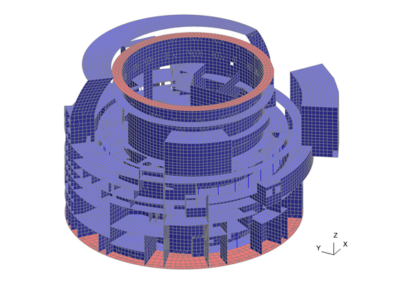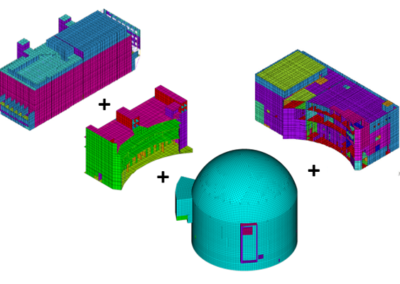Goesgen Nuclear Power Plant Seismic Analyses
Structure-Soil-Structure interaction analysis of the nuclear island and nonlinear SSI analysis of the reactor buildingPROJECT TYPE
LOCATION
OWNER
SC Solutions was contracted to perform structure-soil-structure interaction analysis to determine seismic risk at the Goesgen Nuclear Power Plant. SC Solutions was also contracted to perform the soil-structure interaction seismic analysis of the reactor building at the plant, taking into consideration the nonlinear characteristics of this integrated soil-structure system.
The Goesgen Nuclear Power Plant is located in the Daeniken municipality, Switzerland and was commissioned in 1979. The nuclear island of the plant consists of four buildings: on the west side the heavy reactor building, which is surrounded by the reactor auxiliary building, and on the south side the emergency feed building and switchgear building.
SC Solutions engineers used SC Solutions’ proprietary, high-performance computing Soil Structure Interaction (SSI) analysis tool, SC-SASSI, which enabled execution of a more complex model (141,000 nodes) than could have been accomplished with other existing software, realizing greater accuracy, and ensuring that the project could be completed on schedule.
Structure-Soil-Structure Interaction Analysis of the Nuclear Island
To carry out the evaluation of the complete structural system, an integrated model containing all the nuclear island structures as well as the underlying soil strata with appropriate embedment conditions was assembled, by combining the SSI models for each of the four buildings inside of the nuclear island.
Highlights:
- Building foundations at different elevations
- Narrow gaps between buildings
- Non-uniform embedment conditions
- Large size of the combined SSSI model consisting of a total of 141,000 nodes
- High performance computing using SC-SASSI was instrumental for completing the project within the schedule
SC Solutions’ approach to use a single SSSI model with all four buildings included was made possible through use of SC-SASSI, which takes advantage of modern high-performance computing capabilities.
Use of this approach led to rational seismic risk calculations resulting in higher safety margins. It also confirmed that no pounding occurs between buildings.
Nonlinear SSI Analysis of the Reactor Building
An analysis approach based on the nonlinear time domain analysis was carried out as follows:
- Use the commonly employed equivalent linear approach in the frequency domain
- Perform the time domain analysis on the equivalent system and achieve alignment
- Investigate the effect of nonlinearities, such as soil, structure, and soil-structure interface – one at a time
- Incorporate all nonlinearities in a single time domain model to determine the combined effect on the integrated system response.
Highlights:
- Implementation of soil, structural, and interface nonlinearities
- Frequency versus time domain alignment
- Demonstrated viability of the time domain approach for seismic SSI analysis
- Demonstrated importance of nonlinear effects
- Seismic Risk Reduction
By including nonlinear effects in the seismic analysis, SC Solutions was able to determine realistic seismic demands on the reactor building. This resulted in the reduction of the computed seismic risk.



